How To Develop A Content Marketing Strategy For 2024 (Step-by-Step Guide)
Daniel Trick
Apr 26, 2021
27 min read
Anyone wanting to reach out to audiences online requires a winning content marketing strategy. But how do you create one?
This content marketing strategy guide provides all the answers.
We cover all the basics, such as what a content marketing strategy actually is, as well as providing a 10 step guide to building a content marketing strategy from the ground up.
You’ll learn how to:
- Set your content goals
- Analyze how your existing content is performing
- Discover the best channels for your content
- Create a content calendar
- Create relevant content your audience wants
- Measure the performance of your content marketing strategy
Check out this video for a summary!
Critically, this guide serves as a template you can take away with you to continuously improve your existing content marketing strategy.
What Is A Content Marketing Strategy?
‘Content Marketing Strategy’ and ‘Content Marketing’ work harmoniously but have separate definitions that are often confused.
A content marketing strategy is the HOW & WHY.
It details why you’re creating the content you’re creating and how you’re going to do it.
It’s your plan for your content marketing to achieve your business goals.
Your content marketing strategy will inform the direction of your content. This direction will derive from your goals and target audience’s needs and wants.
Content marketing is the actual creation and distribution of online material, such as videos, social media posts, and blogs, to your target audience.
It must drive customers to desirable actions, such as subscribing to your newsletter or purchasing your products and services.
To appeal to your customers, the content you create must be valuable, relevant, and consistent. And this is where the content marketing strategy comes in.
So for example, your goal might be to build brand awareness.
In this instance, your content marketing might involve creating content that provides an answer to the particular pain point of your target audience, identified from the content marketing strategy.
Why Is A Content Marketing Strategy Important?
Why do you need to create a content marketing strategy in the first place?
- To Boost Conversions
- Control The Conversation
- Increase Loyalty
- Better Promote Products And Services
- Increase SEO
Boost Conversions
Conversion rates are nearly 6 x higher for businesses that adopt a content marketing strategy compared to those that don’t.
Brands that focus on creating targeted blogs, videos, and other types of content get 2.9% of prospects to buy from them, compared to a 0.5% conversion rate for those that do not.
This shows that content marketing is one of the most powerful tools for boosting conversions.
It adds value to the sales journey and increases brand authority.
Control The Conversation
A proper content marketing strategy is also important for controlling your brand’s public image and the conversation surrounding it.
So for instance, to get people to see your brand as an authority in your industry, you could write in-depth white papers or host webinars on subjects in your area.
Another objective might be to communicate the sustainability of your brand. Your content marketing strategy, therefore, might include creating marketing videos showing your audience how you protect the environment.
By tailoring your content in these ways, you can steer the conversation in a direction that is favorable.
Increase Trust & Loyalty
There’s also evidence that quality blogs, videos, and social posts published consistently generate trust and loyalty.
54% of customers say that they will stop shopping with a brand if it doesn’t provide relevant content. And 43% say that they spend more when they feel loyal to it.
Positioning yourself as an authority in your niche is the prime way to build this trust and loyalty. Every time you publish a piece of content, your audience will keep coming back because they know it will benefit them.
Better Promote Products & Services
Lastly, fleshed-out content marketing strategies let you better promote your products and services.
Content marketing is very expansive. It lets you create more useful and in-depth material that makes your value proposition more apparent.
For instance, IT companies with complicated software solutions will often release video tutorials showing their customers how they can take advantage of various features and functions.
Flat-pack furniture brands do something similar. Explainer videos help customers work out how to build the product. They reveal concealed benefits, thereby improving the value proposition.
Brands with exciting products will often distribute unboxing videos on social media, usually via influencers. The goal here is to create a buzz about the product itself and generate purchasing desire in the audience.
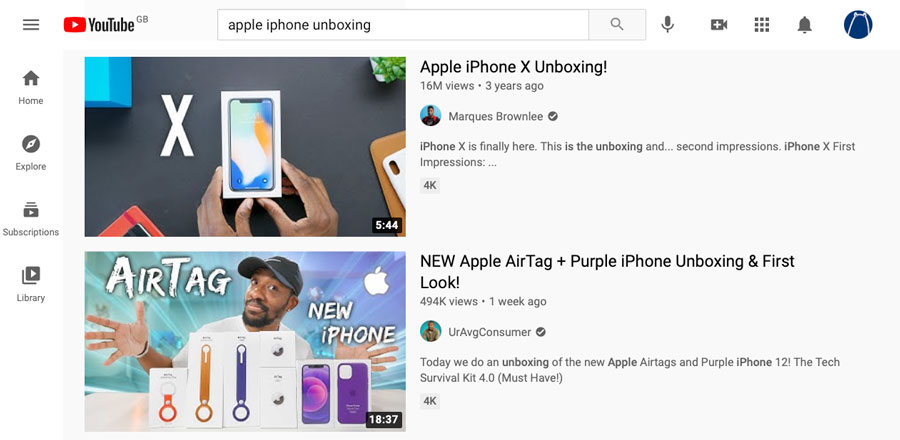
Increasing SEO
A strong content marketing strategy can also boost traffic by enhancing your SEO. When you get content marketing basics right, you can massively improve your SEO and your ranking in the search results. Quality content will gain you more natural backlinks, increase visibility in the search results, increase traffic and increase dwell-time on your pages.
All these factors combined will boost the ranking of both your content and your website in search engine results pages (SERPs) – factors we consider in more detail in the rest of this content marketing guide.
Remember to track your rankings, keywords, and more using free and paid SEO tools. For more information on these, check out our SEO metrics blog post here.
The 3 Elements of Content Distribution
Understanding the types of content distribution is vital for developing a good content marketing strategy.
It concerns how you’ll promote your content marketing to audiences across media channels.
The types of distribution you choose to focus on will depend on your goals, which, in turn, will influence the types of content you choose to create.
Content marketing strategy experts group distribution channels into three categories: paid, owned and earned. Let’s unpack these:
Paid
Paid media distribution pretty much does what it says on the tin: it’s when you pay to get your content in front of an audience.
As you might predict, this can take many forms. Paid media can include pay-per-click (PPC) display ads, social media ads and sponsored content, TV ads, billboards, printed ads, paid content promotions on third-party sites, paid influencers, and retargeting.
For example, you can pay social media sites, such as Facebook, and search engines, such as Google, to distribute your content for you.
Search engines let you pay to display advertising above regular organic SERPs, helping you get noticed without extensive SEO.
And social media sites enable you to promote existing organic posts, not just specialist ads, meaning you can distribute even more content.
While going down the paid media route requires spending money and conversion rates can also be lower than owned or earned content, it builds brand awareness and allows you to get your content in front of a large number of your target audience immediately. You don’t have to wait for it to happen organically.
This approach to content distribution is great for new companies just starting out. It is also helpful for established brands who want to get more eyeballs on their content. Paid media is ideal for building brand awareness which is why a good mix of all 3 content types is beneficial.
Owned
Owned media is the content that you control.
This is where you distribute content through web properties you already own, such as your website, social media accounts, blog, microsite or newsletter.
Owned media is a must because it gives you total control over the content you create.
Furthermore, there’s no time limit to the opportunity. Once the content on your properties becomes successful, prospects can return to them time and time again without incremental fees.
Building owned media distribution channels requires using all the standard tools of digital marketing: SEO, social media outreach, email list building, you website! Throughout everything, the goal is always to raise the profile of all the channels you own.
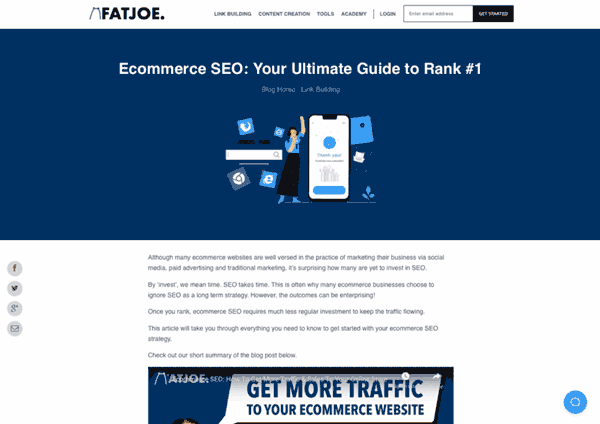
How do you do it? Simple: create content designed to be published on your own accounts that reflect your brand and are written specifically for your audience.
More specific examples of owned media include:
- Blog posts
- Publishing videos alongside your blog posts
- Publishing content on your social channels
- Product information on product pages, such as descriptions
- Infographics
Did you know that fatjoe can help you promote your owned content organically? We offer numerous services that can support your owned content creation, and promote the content that already exists on your website. Gain natural in-content backlinks to your blog posts with our Blogger Outreach Service, or greatly improve your product descriptions game with our Product Descriptions Writing Service.
Earned
Defining the difference between earned and owned media is all about the level of control.
Earned media refers to all the content that you have no control over.
Earned media is generated externally to your business and could be created by:
- Customers
- The media
- Social media users
- Other blog/website owners
Here are some examples of the specific type of media it could include:
- Inclusions in magazines articles or “top 10” blogs you haven’t paid for.
- Reviews of your products by customers, affiliate marketers and third-party review sites.
- The republishing of your infographics in third-party publications and pages.
- User generated content on social media such as images or videos of your products in their homes.
The benefits of earned media can be considerable, often outstripping owned and paid media combined. Here’s why:
It’ll boost you to the top of the search results
Brand mentions and backlinks are one of Google’s top ranking factors. Many websites “earn” backlinks by creating high-quality, shareable content that will naturally attract incoming links and mentions from other sites.
These mentions are classed as earned backlinks for this reason
Generally, this is the preferred way to earn backlinks according to Google so will greatly boost your SEO and ranking within the search results. You can read more about earning backlinks and links mentioned in our guide to backlinks.
Word of mouth is a powerful marketing tool
Not having control over distribution might sound like a negative, but, again, it can work in your favor. When users share their satisfaction with a brand, it’s passing on a recommendation. 92% of people trust recommendations from friends and family over any other type of advertising according to Nielsen. Need we say more?
Where word of mouth was once more literal, it now refers to reviews and recommendations passed through social media.
The Fine Line
It’s also important to note that the terms “paid”, “owned” and “earned” can overlap, and there is some controversy about which category various types of content distribution fall into.
You’ll notice that some of the channels fall under multiple categories.
For example, social media.
Social Media comes underpaid, owned, and earned depending on the type of content.
- User generated content is earned from customers writing reviews or comments or posting photos containing your product.
- Content you’re publishing from your own branded channels is owned, including content employees share on LinkedIn.
- Paid content includes any social advertising such as sponsored posts.
This is because we’re referring to the types of content that can be found on social media and each of these is created under various circumstances.
Also, there are some fine lines with regards to ‘earned’, you can pay for some services to earn this content for you.
For example with press release distribution. fatjoe will distribute newsworthy content about your brand to 350+ news outlets & 100,000+ journalists.
If the stories are engaging, the journalists will take the stories and create content mentioning your brand, resulting in earned content.
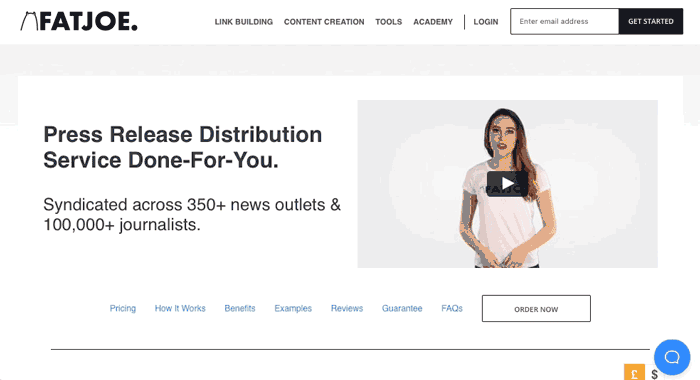
You may also create owned content through our infographic design service and publish the infographic on your website. But then if someone was to publish it on their website, it becomes earned.
Some smaller companies may also choose to send an influencer a sample, or even a full version, of your product or service. Depending on the terms agreed prior to sending the product, they may or may not create some content.
Does this fall underpaid or earned?
Technically earned because it’s a review that you haven’t paid for, but you have offered a product or service at your expense. You can see the complications here.
10 Steps To Developing A Content Marketing Strategy
So now that we have the content marketing basics covered, how do you actually develop a comprehensive content marketing strategy?
We’ve boiled the process down to 10 steps that you can follow to develop a comprehensive content marketing strategy for 2021.
Step 1: Know Your Audience
When it comes to your content marketing best practices, knowing your audience is up there in importance.
But how do you find out more about them?
Define Your Audience’s Demographics And Psychographics
The first step is to define your audience’s characteristics so you can get a better idea of the type of content they want.
Start by looking at the people who are buying from you already. Almost always, they will be a representative sample of the type of person you should be targeting.
For demographics, you’ll need to consider:
- Age
- Gender
- Occupation
- Level of education
- Income
- Marital status
- Location
Once you define these parameters, go back and cross-check to see if your competitors are targeting them.
If you notice any discrepancies, ask yourself why. Is it because you have a slightly different product? Or is it because you’re targeting the wrong kind of person?
You also need to define your audience’s psychographics – your customers’ personal characteristics.
Ask yourself what values and attitudes they have, how they behave, their personality structure and their lifestyles. Later on, you can use this information to create the type of content your audience will enjoy and engage with – everything from the subject matter to the tone of voice.
Create A Customer Persona
Once you collect all this information, you can create a customer persona – an archetype that represents the person who buys from your brand, or you want to buy from your brand.
Ideally, your customer persona should embody traits shared by the majority of your audience – the demographics and psychographics outlined above.
Throughout this process:
- Try to reframe your thinking so that you see things from your customers’ perspectives.
- Avoid using the usual corporate buzzwords, and speak in a language they will understand.
- Make sure that you address their priorities and not your own.
Getting your customer persona right helps you to show your audience that you really understand them, helping to build loyalty and trust.
Discover What Your Customers Truly Value
If you want your content to have an impact, you need to understand what your customers actually value.
A lot of companies will write content that relates to product features. There is nothing wrong with that per se, but most customers are more interested in the benefits and outcomes your products provide. That’s where you can truly elevate your content.
For example, a company selling sofas may create a blog post about how to buy a sofa in which they explain how to choose a color and fabric, etc.
However, in understanding their audience, they may find that they value quality over anything else.

So the content will want to be tailored more towards explaining how to determine the quality of the sofa and what makes a good quality sofa. This is how to attract your target audience through your content marketing.
Engage Them Dynamically
Once you’ve collated your ideal customer persona (ICP) Customize and modify your content marketing materials to embrace dynamic elements that will speak directly to the particular person who lands on your content, engaging them more and building rapport faster.
Step 2. Set your goals
Once you arrive at an accurate customer persona, the next step is to set content marketing goals.
Goal setting is an important part of your content marketing strategy because it helps you later measure its effectiveness.
You could, for example, create wonderful in-depth content about how to use your products. But if your goal is to raise brand awareness, that type of content marketing might not benefit you at all!
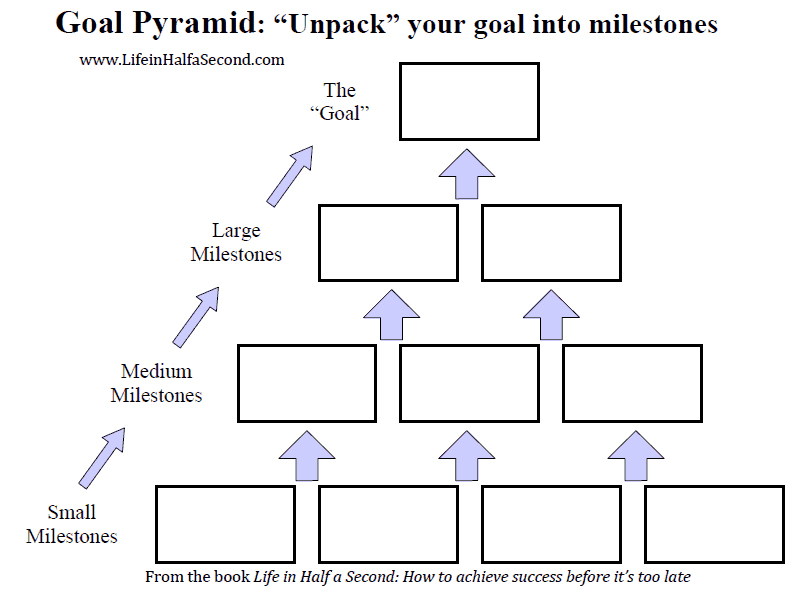
At the top level, you have your brand’s vision and mission. These goals reflect why your company exists in the first place and what you’re trying to achieve. Any content you create should bring you closer to the overall vision and mission in some way.
At the middle level, you want to think about your strategic goals: how are you going to use your content to “win”?
A goal in this area could be to fill a content niche left open by your competitors or to provide more entertaining content than your rivals.
At the bottom level, you have your short-range operational goals. These concern how your content will contribute to your business’s immediate needs (usually sales or conversion related).
Ideally, any material you outline in your content marketing strategy should dovetail with these goals.
How To Set Goals For Your Content Marketing Strategy
When it comes to goal setting, most companies use either SMART or CLEAR frameworks.
SMART is an acronym for the following goal-setting process:
- Specific: Any goal you choose should be trying to achieve something in particular
- Measurable: There should be a way to measure whether you’ve achieved your goal. You should also have systems in place to track your progress towards your goals to see whether you’ve attained them.
- Achievable: There should also be a realistic chance that you can actually achieve your goals.
- Relevant: Relevancy is critical for your content marketing strategy. It involves asking questions such as, “is now the right time to release content?” And “is the goal relevant to my audience?” and “Is my goal relevant to my business? Think back to your company’s vision and mission.
- Time-bound: Lastly, under the SMART framework, there should be a time limit on how long you have to work towards a goal and how quickly you’d like to achieve it.
The goals you choose depend on what your business needs your content marketing to achieve.
Here are some lose examples that would require more detail:
- To increase awareness of your brand: Perhaps you are a startup and your audience doesn’t yet know about your services. In this case, you’ll need to engage in “top of the funnel” content marketing to appeal to prospects who haven’t heard about you before.
- To increase engagement: Brands target user engagement when they want to make sure that they produce content their customers really care about. Long-term, higher user engagement can boost conventions.
- To increase trust: Perhaps your audience doesn’t fully understand your brand yet. In which case, you’ll want your goals to reflect this fact. Building trust might require posting articles about your social responsibility on social media or establishing yourself as an authority in white papers.
- Educate your audience: Perhaps your clients don’t know enough about your products yet to figure out whether they can benefit from them or not. In that case, your content marketing goals consider this. Try asking your sales team the types of questions that customers usually ask to get a better picture of their requirements. Then make a note of what they say so that you can better plan relevant content later.
You also need to decide on the key performance indicators (KPIs) for content marketing. How will you know you’ve achieved your goals?
The best KPIs have the following properties:
- You can measure progress towards them with a progress indicator running from 0 to 100%
- They can adjust, depending on progress
Step 3: Assess your current position
Once you define your goals, the next step is to take stock of your current content marketing position.
Websites post more than 4.4 million blog posts daily. So if you’re not targeting your precise niche with your content, you could be wasting your time!
A content audit is just a process for systematically assessing all of the content on your website and finding out what has been successful, and what hasn’t, so you can improve new and existing content based on your SMART goals.
Once you have a sense of the type of content your audience wants, you improve your capacity to create more relevant content in the future.
How To Perform A Content Audit
Carrying out a content audit is surprisingly simple, once you know how.
Take Stock Of Your Existing Content
Before you can analyze your content, you need to take stock of what you already have.
To create an inventory, start by collecting all of the URLs of the web pages that you want to analyze.
Some brands enter these into spreadsheets manually.
However, it is usually easier to use a content audit tool, such as the one SEMrush provides.
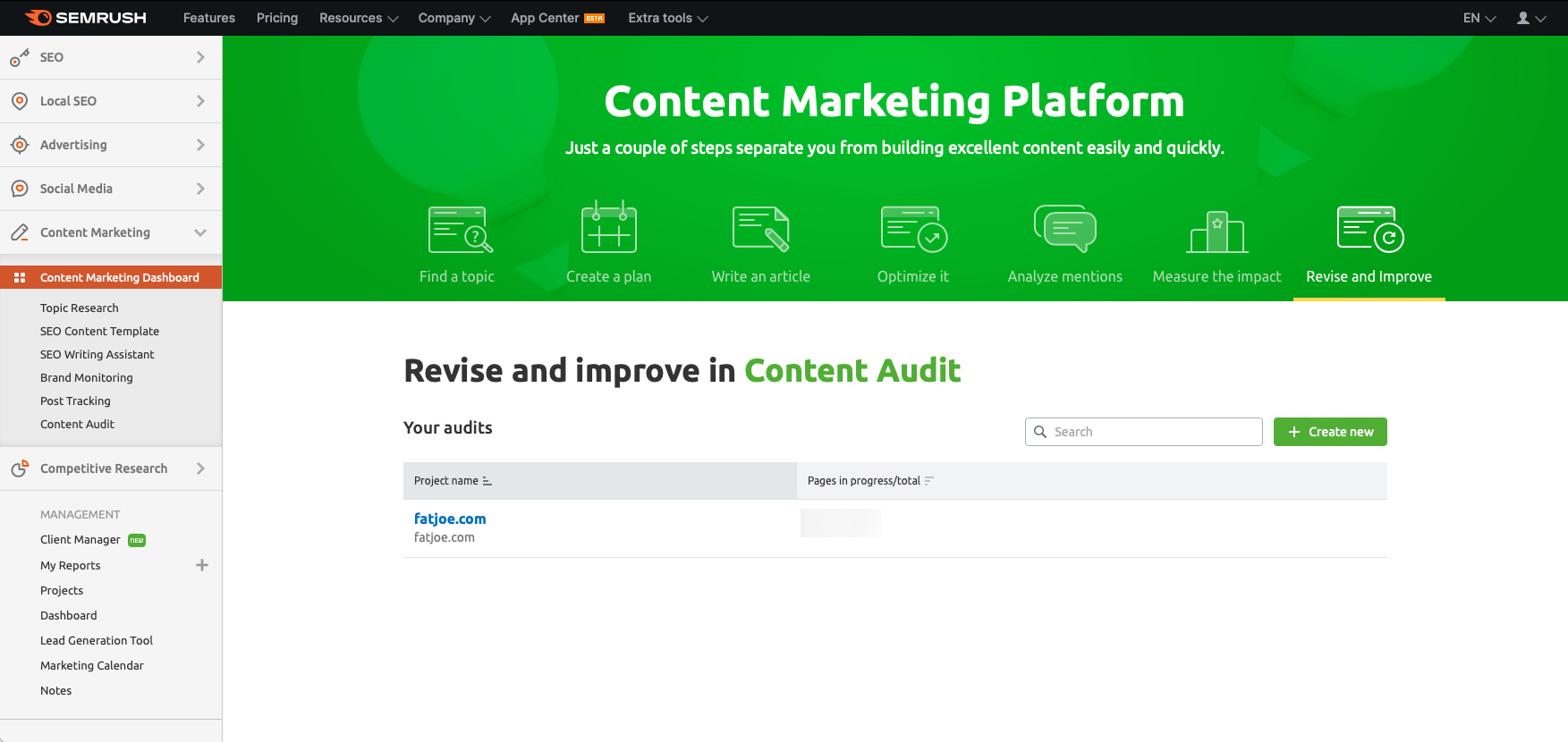
SEMrush’s Content Audit tool integrates with Google Analytics and Google Search Console providing data on session duration, bounce rates, and search queries.
This tool can scan your site map (a directory of all the pages in your domain) and then provide you with existing metrics that can support your audit (such as page views).
Assign It To Categories
Once you have your list of content, the next step is to assign it to various categories which you can then track.
Common categories include:
- The date you published the content
- Word count
- Buyer journey stages with which the content addresses – such as awareness, consideration, and decision
- Content format, including blog posts, videos, landing pages, ebooks, etc.
- Author of the content (if you have multiple people writing for you)
- Content features – such as text, images, info-graphics, and whether there are calls-to-action
Once you’ve done this, you can arrange all your content URLs into a spreadsheet ready for analysis.
Analyze Your Content
Most brands like to analyze the quality of their content using metrics.
The metrics you choose relate to the goals you set for your content marketing. Common metrics include:
- Shares content received from social sharing buttons
- Backlinks generated from third-party sites
- Number of user sessions
- The average duration of user sessions
- Bounce rate – the number of people rapidly clicking off your webpage
- Number of related search queries
- Number of leads and conversions generated by content
Interpret Your Data
Lastly, you’ll need to interpret the data.
Once you link your categories to content quality metrics, you’ll notice that content in some categories is much more successful than in others.
Low session durations and high bounce rates usually indicate that your content didn’t deliver what customers wanted. Your task is to figure out why.

Sometimes the answer will be obvious: you didn’t provide an answer to the title of the blog.
But other times, the issue can be more subtle. Perhaps the call-to-action button at the end of the page doesn’t work, or your content just takes too long to load.
You need to use this evaluation to understand the gaps in your existing content so that you can apply these improvements to your new content marketing strategy.
Find Your USP
The last step is to assess what makes your content unique. Or even what is it about your content, tone of voice or business that could make your content unique. This is also known as finding your Unique Selling Point (USP).
Things that make you stand out from the crowd might include:
- Offering information not available anywhere else.
- Presenting content in an entertaining manner.
- Offering practical knowledge that guides users through the problems they face.
- Discussing complex subject matter in simple, accessible terms.
- Mixing up your written content with other media formats to make it more engaging.
- The extremely targeted niche that your content is aimed at.
We recommend writing a targeted 3 or 5 point list of the specific things that make you unique.
This list should become your content bible. All your content should sit within these 3-5 USPs. This will help you decide which types of content to create in the future.
Bringing These Steps Together
Now think carefully about how your existing position can determine the direction that you take your new content.
You can also use data from your site audit to better characterize the type of content your audience wants that you may not be offering with your existing content. This allows you to:
- Discover topic areas that engage your prospects.
- Focus on creating content that most appeals to your audience.
- Discover the type of content that generates the most backlinks for SEO – perhaps your statistics posts or infographics.
- Find content gaps.
- Create more of the content your business is uniquely positioned to create because of its specific expertise.
You might even choose to repurpose or re-imagine your existing content which is one of the quickest SEO wins. Even if it is currently performing poorly, you can still use it to benefit your brand. Thinking about the outcomes from your audit and your 3-5 USPs, you could:
- Add videos to existing blog content, presenting it more visually
- Repurpose or update existing content to make it more relevant, based on the findings of your analysis
- Republish existing website content on social media or third-party websites
- Lift snippets from your successful blogs and use them in your email marketing
Step 4: Solve An Issue
Content is most effective when it solves customers’ problems. So your content marketing strategy should include direction on how to do this effectively.
But how do you discover your customers’ pain points?
That’s where the customer persona you just created comes in handy. You want to use it as a prompt to put yourself in your customers’ shoes so you can think about the issues that affect them.
Your customer persona, for instance, might be telling you that your customers:
- Are busy people who need content to help them find time to benefit from your services.
- Are searching for premium products, but are finding it hard to find them.
- Want cheaper products.
- Are struggling to navigate the buying process.
The next step is to adapt your content marketing strategy around these pain points using all the information you have collected so far about your audience.
Here you need to consider the topics of your content. What questions are your target readers asking that you can provide a quality answer to?
Naturally, you should include, not only the type of content you need to publish within your content marketing strategy but the best distribution channels and formats to use to deliver the message.
What format should you provide this answer based on their most-used and most engaged with channels?
For instance, does your audience prefer watching videos on YouTube? If so, you could create videos to solve their pain points.

Likewise, do they prefer reading in-depth articles on your blog? If so, then you might want to create guides or explainer posts to resolve issues.
By following the above process, you can quickly discover content gaps and plug them using the right media, delivering quality, relevant topics that are published on all the right content channels.
If you choose to create YouTube videos, you can check out our detailed guide to ranking videos for 2022:
Step 5: Research Content Channels
Talking of content channels, the next step of creating a content marketing strategy is to research suitable channels for your content. But what exactly is a “channel?”
A content channel is simply any platform you use to distribute your content.
And when you think about it, there’s a lot of them.
Content distribution channels include:
- Your website
- Your social media accounts
- Your blog
- Email newsletter
- Third-party blogs and social media accounts
- Forums
- Reviews and review sites
- Guest posts
- Influencer content
- Social and search ads
As a brand, you need to decide on which content distribution channels you’re going to use. And here’s where your customer persona comes in handy: you can use whatever you came up with to determine which channels you ought to use.
Some audiences – perhaps young professionals – will prefer to consume content on forum sites like Reddit or Quora. Other audiences, such as young fashionistas, might prefer Instagram. Ultimately, you need to pick and choose the channels likely to engage your audience the most.
When considering this question, also think about which channels suit the type of content your brand strategy suggests you should create.
- YouTube is great for videos (obviously!)
- Social media is good for media-rich blog posts and infographics
- Your own website could be the ideal vehicle for publishing detailed, in-depth content and distributing downloadable ebooks and white papers
Lastly, check that your content ideas align with the platforms your audience uses. In the perfect scenario, you’ll aim to distribute content via channels that both accept your desired format and engage your audience. However, sometimes, there might be a mismatch.
You might find a channel, TikTok for example, where your target audience likes, shares, comments and views a lot of content. But you may really like writing and want to create loads of in-depth blog posts that, of course, don’t work well on TikTok.

Usually, in this situation, it’s best to double-down on the platform your audience uses and adjust your content type to match.
Catering to your audience’s needs where they are right now is the aim of the content marketing strategy game. Ultimately, you want to distribute compatible content via channels that engage your audience the most.
Step 6: Resources
Planning is all well and good. But if you don’t have the resources to execute your content marketing strategy, then it won’t serve you.
In light of this, you need to be realistic about what you can achieve. (Remember our SMART goals!)
Think carefully about what resources you already have, what you might need in the future, and what you might need to outsource.
What you’ll be able to achieve depends considerably on your brand, industry, team size and marketing budget.
Let’s break down the resources you’ll need into categories and explore each of them:
Human Resources
Human resources are the people you’ll need to imagine, create and distribute your content. For example, you could require:
- Skilled writers who can communicate engagingly
- Videographers and video editors who can know how to put together compelling videos
- Graphic designers to create any visual media your content requires
Some members of your enterprise (or you personally) can carry out several of these functions. However, it is often more efficient to simply outsource all or part of the process to third parties. You can request skilled writers to generate SEO-optimized content for your blog, graphic designers to create infographics, and video editors to produce stunning videos that sell your products.
Be honest about your in-house ability to provide all these skills. If you believe you’ll need extra support to achieve your goals, include that in your content marketing strategy.
Content Creation Tools & Resources
You’ll also need to consider the tools and resources available to you. These could include:
- Spelling and grammar-checking tools, such as Grammarly and Hemingway
- Graphic creation tools, such as Canva and Photoshop
- Video hosting and creation tools, such as Vimeo
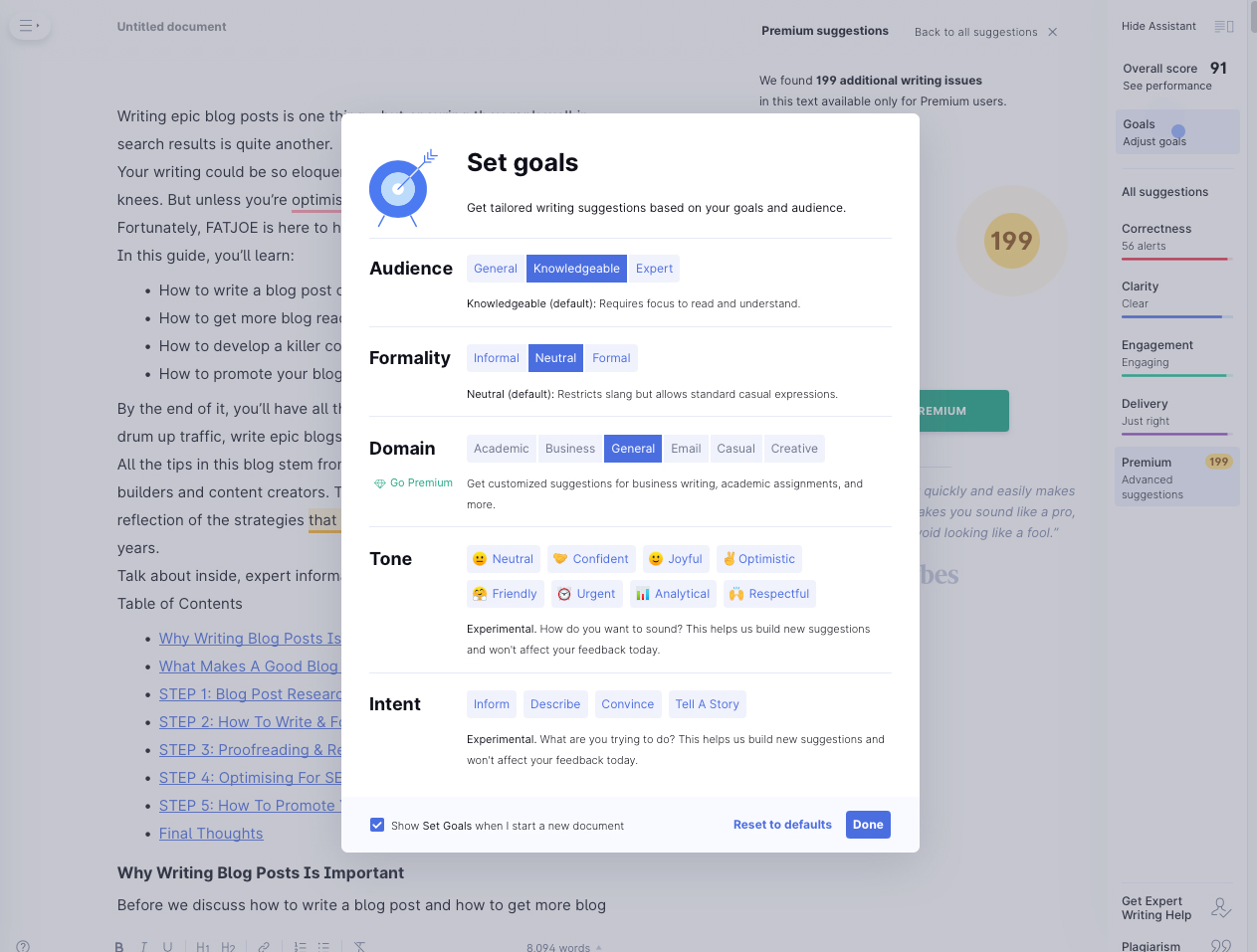
Some resources are free, while others are paid. It will be up to you to decide whether premium versions provide sufficient return on investment based on the content you’ll be creating and how frequently you’ll be creating it.
Financial Resources
Lastly, you’ll need to think about money.
Financial resource considerations usually tie in with the above constraints.
Considering financial limitations means accepting the constraints that your enterprise faces. While you may find that it’s more financially viable to keep your content creation in-house, you may also find it’s better to outsource elements of your content creation.
If you can see that you don’t have the resources you need to achieve your objectives, you may need to revisit your goal setting.
Remember, under both SMART and CLEAR schemes, goals need to be realistic.
Step 7: Decide On The Content Types
We already discussed content types above briefly. But as a quick recap, it is the format your content takes.
You can break them down into visual, text, video-based, interactive and PDF (which are usually long-form).
As a brand, you’ll need to brainstorm the content types you’ll use.
But how do you brainstorm effectively? Here are some of our suggestions:
- Investigate what’s working in other industries and see whether you can apply those approaches to yours. Sometimes, sectors can become narrow-minded about which types of content will work for them. Think about other brands that your customer personas follow outside of your own industry. Branching out and looking at what other sectors are doing can often give you some great ideas for your enterprise.
- Record all your ideas on a spreadsheet. There’s no such thing as a bad idea. Sometimes, you’ll come up with a content idea that isn’t suitable right now but could work in the future. Keeping all your ideas lets you build on them later on.
- Talk to people outside of your marketing team, including your target customers! Marketing professionals can occasionally get tunnel vision, assuming that only a particular type of content will work. No one knows your customers better than your customers! Involving people from other parts of your organization, or even your target audience themselves can help broaden the creative process and generate more out-of-the-box thinking.
- Think about the type of content your audience will enjoy. Base this on your customer persona as discussed above.
- Create a swipe file of content types that worked for other brands. Having a collection of successful content marketing campaign formats can help your team settle on something that will work for your business.
Here’s a list of content types you might want to consider during your brainstorming session:
- Blog Posts
- Infographics
- Product Descriptions
- Videos
- Educational Articles
- Press Releases
- Webpages
- Reviews
- Guides
Matching various content types to your content marketing strategy can be a little challenging, so here are some of our top tips:
Blog Posts to Build SEO
Data suggests that businesses that use blogs get 97% more backlinks to their websites than those that don’t — great if your goal is to drive generate social shares and backlinks.
Blog Posts to target customers in the consideration stage of the buying cycle.
Effective writing can convince your customers that you (and you alone) provide the solutions they need – ideal for building relationships.
Product Descriptions for the decision stage of the buying cycle.
Content should be about overcoming “pain points” and generating desire for whatever you sell, encouraging conversions. Product descriptions that clearly describe the product and its benefits will help you bring in more revenue and prevent prospects from switching to a competitor.
Educational articles to build brand authority.
Setting yourself up as the teacher creates a psychodynamic that signals your expertise. This approach is suitable for brands looking to spread brand awareness, educate their audience and build relationships.
Videos to generate awareness.
Posting easy-to-digest video content on social media platforms introduces your brand to people who won’t read your regular text-based content. For instance, you could create a 20-second video posted to Facebook describing the problem your company solves and why it’s so amazing for customers.
Step 8: Create A Content Calendar
Any content marketing strategy worth its salt also needs a content calendar – a written schedule that describes when and where you will create and post your content.
They enable you to:
- Organise your content marketing and keep it on track
- Produce quality content consistently by copy-editing text and including information checking into your workflows
- Marshal your content creation resources as efficiently as possible
- Avoid last-minute topic planning and allow ample time for proper creation and execution
- Deepen your understanding of customers by tracking whether publication timing affects views and conversions
How To Create A Content Calendar
Choose A Content Calendar Tool
First, you’ll need a suitable tool that allows your team to create, manage and collaborate on your content calendar.
Here, there are plenty of options:
- Google Sheets – a popular free option, suitable for small teams.
- Trello – the team and task management tool we use to plan all our content. It’s a simple drag and drop interface which is ideal for list-lovers.
- Coschedule – a purpose-built tool that comes as part of a larger marketing suite for solopreneurs, small businesses and large enterprises
- Smartsheet – great for collaboration, particularly if you work with multiple clients or agencies.
- Basecamp – primarily a project management tool, but can also facilitate content calendar creation
- Editorial Calendar for WordPress – a free WordPress-centric with a simple drag-and-drop interface
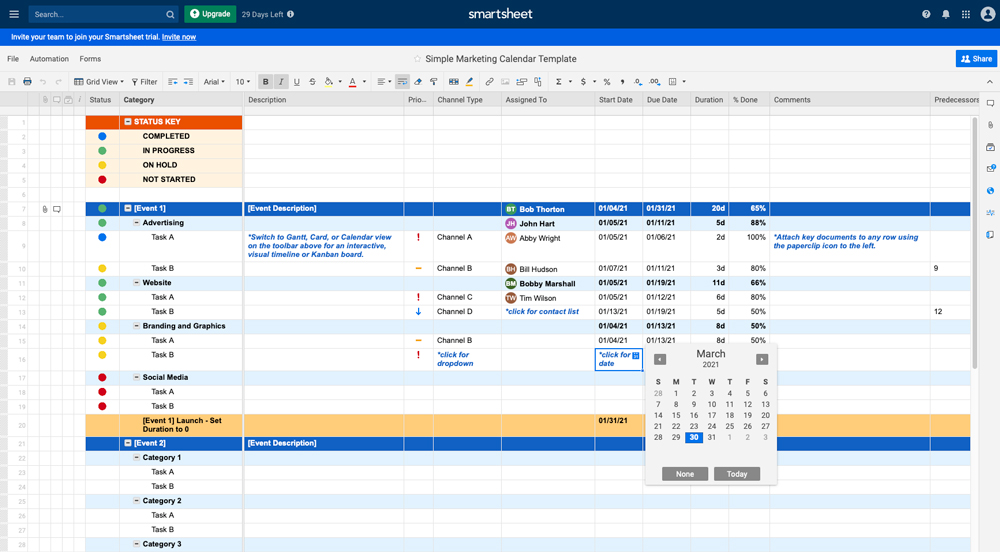
Once you choose a tool, the next stage is to begin fleshing it out.
Here’s what you’ll need to decide:
- The publication frequency – how often you’ll want to publish posts through various channels. You’ll also want to publish content that coincides with events that your customers consider important throughout the year. Perhaps you sell beachwear and it’s the summer holiday season. Or maybe you want to flog your Valentine’s Day lines. Your schedule should accommodate these events. Sometimes, your calendar will include self-imposed deadlines. Brands launching new products or services, for instance, often need to create content to build excitement before they go live.
- The actual content you’ll produce – something you can generate from the brainstorming stage
- The channels you’ll publish on – such as your website, LinkedIn or Facebook
- The times you’ll publish – concrete deadlines for distributing content to your audience. Your content calendar should reflect what you know about your audience already. Some audiences prefer to receive content earlier in the day, while others want it later on.
You should note that creating a content calendar is a holistic process that requires you to consider many of the steps outlined so far. For instance, any content calendar you create needs to chime with your overall goals. Content production needs to be frequent enough to work towards your objectives, such as better SEO or greater brand awareness. And you also need to publish it on the right platforms to build revenue.
Step 9: Create Content
Now that you’ve done all that, it’s time to actually get on with content creation.
The title of this step is pretty self-explanatory, but when creating content, you’ll need to work backwards.
Let’s say that you want to post a video for an upcoming holiday season. Before you do that, you’ll need to ensure that you’re thoroughly prepared and that you have enough time to plan, edit, and publish the content before the deadline.
You’ll need to go back to your content calendar and check whether you have the necessary time and resources.
Think about how you’re going to be creating this content based on step 6. You may need to set aside more time if you plan to create the content in-house. However, if you’re outsourcing your content to an agency that can turn it around within a couple of days, you may find you can churn out more content quicker. It all depends on your chosen strategy.
Step 10: Measure Your Results
Lastly, we recommend you use data to assess the effectiveness of your content marketing strategy.
You’ll need to measure results based on the overall goals of your strategy.
Why does this matter? Simple: tracking your content marketing performance tells you whether you are moving towards your goals. Having the right data to hand shows you if you’re expanding your reach, boosting brand awareness, and increasing sales and conversions – the goals you care about most.
Here’s a table of example goals and key performance indicators (KPIs) for tracking them.
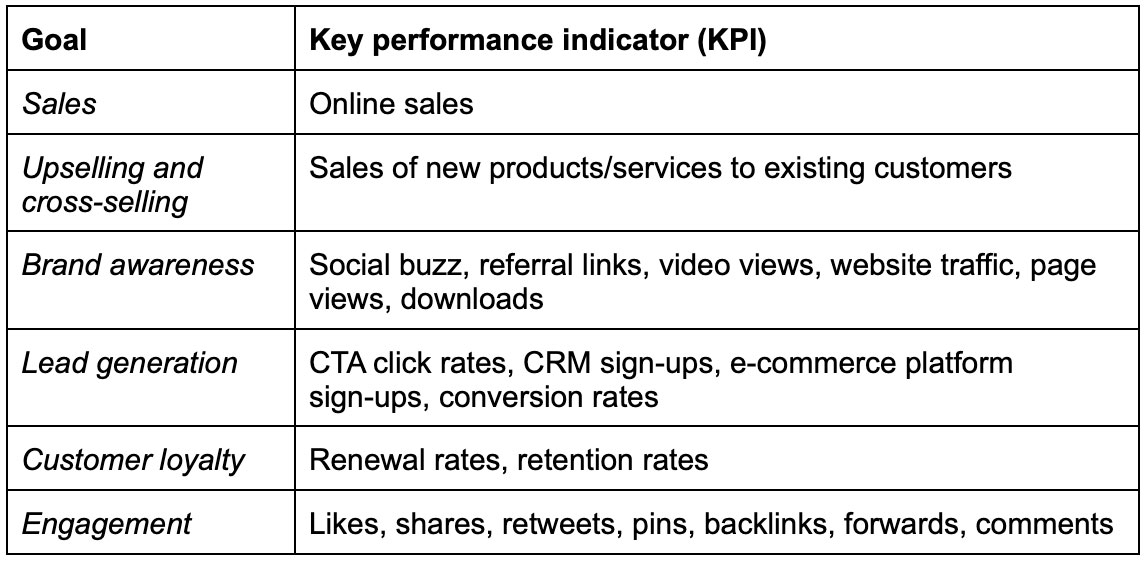
In each case, you’ll want to track the results from your content marketing only, not other marketing channels.
Keeping track of how your owned content marketing is fulfilling your business goals is important. Google’s Analytics tool lets you automate the process.
Google Analytics measures the success of your current content strategy. You can:
- Check the traffic to each content piece using the URL: You will find that some content pieces that really engage your audience get an enormous number of hits, while others receive hardly any.
- Check engagement metrics, such as bounce rate and time spent on page: These metrics are essential because they tell you whether your content actually interests your target audience. The bounce rate (the proportion of users who quickly click “back” to search) and “time spent on page” suggest page quality. The more time users spend consuming your content, the more valuable you can assume it is.
- Check the source/medium of the traffic: You can see which channels (i.e. social media, regular search or paid) are generating the best results. You can then use this information to double-down on particular channels and avoid others that don’t seem to be performing.
If you are an e-commerce company, you can also use e-commerce platform metrics to track the success of your content marketing strategy. Typically, firms will use KPIs such as sales conversion rates, email opt-ins, customer acquisition cost, average order value and revenue by traffic source to check that their content is performing.
Measure Your Search Visibility
If search results visibility matters for your content marketing strategy, you can track the performance of individual URLs using tools like Ahrefs Site Explorer. Simply paste your domain or URL into the search bar and then click the search button.
This tool lets you track a range of metrics to determine how your content marketing is performing. Including:
- URL rating: Ahrefs’ URL rating shows the strength of the page’s backlink profile on a log scale, running from 0 to 100. Sites with the fewest backlinks have a low rating, while those with the most have a higher rating.

- Ranking position in the SERPs: Ranking position in SERPs is critical for brands that want to use content marketing to increase their visibility. Ahrefs defines this as your page’s position in organic (non-paid) search results on Google.

- Backlinks: You can also use Ahrefs to see how many backlinks your content is generating. The more noteworthy, original, informative and engaging it is, the more likely other sites will link to it. As discussed, this is critical for SEO performance and overall brand awareness. The higher your content appears for search, the more traffic will arrive on your site.

Measure Your Social Media Performance
Lastly, if you’re sharing on social media, you can use the platform’s analytics tools to judge the success of your content. These tools allow you to measure a range of metrics.
Facebook Insights, for instance, shows you engagement statistics associated with your posts, along with the reach (how many people see your content). It also shows you things like page likes and follows, impressions, and your click-through-rate.
Google Analytics Attribution integrates with Facebook and other traffic sources. This is handy because it shows you the sources of all referral traffic arriving at your website.
Check out this video for even more detail on the various SEO metrics and which you should be tracking.
What To Do If Your Content Marketing Strategy Isn’t Working
Sometimes your data will tell you that your current approach isn’t driving you towards your goals. If so, you can return to step three of this content marketing guide and work back through it a second time.
You won’t usually need to revisit steps 1 and 2 – knowing your audience and setting your goals – as these are likely to stay the same. However, you may need to adjust your marketing channels, content type or issues you are trying to solve.
Lastly, if you notice that your popular articles are dipping in popularity, you can update them using the steps outlined in this guide to content marketing. Be candid about whether they still solve the issues that matter to your audience. Also ask if you are distributing them through the correct channels and presenting them in the correct format. Make any necessary changes and then see how they perform. You can then use the data you collect to improve other content that might be flagging.
Final Thoughts
This 10 step content marketing strategy guide taught you a lot.
You learned what a content marketing strategy is and the steps for creating one, including choosing the right goals, audiences, channels types of content marketing, and calendar. You also discovered the importance of measuring content marketing outcomes and using data generated to improve your existing approach.
Ultimately, you discovered why content marketing strategies are beneficial. You learned that they:
- Boost conversions
- Help you control the conversation
- Increase loyalty
- Improve how you promote your products and services
So, with the right approach to content marketing, your brand could achieve exceptional results.
Become a Pro at SEO
Join 65,000 others and learn the secrets to SEO success with our weekly blog posts.

